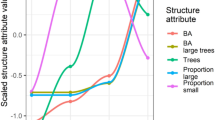Abstract
Old-growth forests are declining throughout eastern North America, especially toward the northern limit of the deciduous formation where gently undulating topography and milder climate especially encourage human activity. Remnants exist, but do they retain the defining characteristics of the original vegetation? The objective was to marshal information required to answer this question, and toward this objective we assessed vegetation in a small 1 ha remnant of maple-beech forest with no history of past logging and compared it to well known and larger old-growth areas in the region. We used Curtis’s (1959) Point Quarter method to provide full quantitative data for trees, saplings, shrub and herbs. Size class distribution of trees and successional status of the stand were assessed. As a general conclusion, we found that tree species richness of our remnant was higher than most recognized large old-growth forests and, while the herbaceous understorey was poorer in species than larger tracts, it exhibited three provincially rare species. Furthermore, the successional status and structural complexity of the remnant were typical of old-growth forests. In overall comparative terms, the remnant was found not be an outlier when ordinated with larger forests. It thus is safe to conclude that this remnant constitutes an ecological benchmark well worth protection, despite its limited size.
Similar content being viewed by others
Abbreviations
- asl:
-
above sea level
- BABH:
-
basal area 1 m above ground
- DBH:
-
diameter 1 m above ground
- DCA:
-
detrended correspondence analysis
- DF:
-
density-frequency index or sum of relative frequency and relative density
- DFD:
-
sum of relative density; relative frequency and relative dominance also called importance value
- UWO:
-
University of Western Ontario
References
Ball, P.W., and D.J. White. 1982. Cyperaceae. In: G.W. Argus and D.J. White (eds.), Atlas of the Rare Vascular Plants of Ontario. Botany Division; National Museum of Science, Ottawa, pp.
Brisson, J., Y. Bergeron and A. Bouchard. 1992. The history and tree stratum of an old-growth forest of Haut-Saint-Laurent Region, Quebec. Nat. Areas J. 12:3–9.
Burke, D.M., and E. Nol. 1998. Edge and fragment size effects on the vegetation of deciduous forests in Ontario, Canada. Nat. AreasJ. 18:45–53.
Curtis, J.T. 1959. The Vegetation of Wisconsin. University of Wis-consin Press. Madison, Wisconsin.
Dreimanis, A., C.G. Winder, and R.A. Altonen. 1998. London, Ontario: Geology. Geomorphology. Geodata. In: P.F. Karrow and O.L. White (eds), Urban Geology of Canadian Cities. Geological Association of Canada Special Paper 42. pp. 237–260.
Fernald, M.L. 1950. Gray’s Manual of Botany. D. Van Nostrand Company, New York.
Habeck, J.R. 1988. Old-growth forests in the northern Rocky Moun-tains. Nat. Areas J. 8:202–211.
Hill, M.O. and H.G. Gauch. 1980. Detrended Correspondence Analysis: an improved ordination technique. Vegetatio 42:42–58.
Honnay, O., P. Endels, H. Vereecken, and M. Hermy. 1999. The role of patch area and habitat diversity in explaining native plant species richness in disturbed suburban forest patches in Northern Belgium. Biodiversity Research 5:129–141.
Hunter, M.L., and A.S. White. 1997. Ecological thresholds and the definition of old-growth forest stands. Nat. AreasJ. 17:292–296.
Juday, G.P. 1988. Old-growth forests and natural areas: an introduction. Nat. Areas J. 8:3–6.
Keddy, C. 1984. Celastraceae. In: G.W. Argus and D.J. White (eds), Atlas of the Rare Vascular Plants of Ontario. Botany Division, National Museum of Science, Ottawa, pp.
Leopold, D.J., C. Reschke and D.S. Smith. 1988. Old-growth forests of Adirondack Park, New York. Nat. AreasJ. 8:166–189.
Leverett, R. 1991. Identifying old-growth forest in the East. Wild Earth 1:30–34.
Leverett, R. 1996. Definitions and history. In: M.B. Davis (ed), East-ern Old-growth Forests. Island Press, pp. 3–17.
Martin, W.H. 1992. Characteristics of old-growth mixed mesophytic forests. Nat. Areas J. 12:127–135.
Maycock, P.F. 1963. The phytosociology of the deciduous forests of extreme southern Ontario. Can. J. Bot. 41:379–438.
McNab, J. 1835. On the local distribution of different species of trees in the native forests of America. Quarterly Journal of Agriculture 5:594–605.
Nowacki, G.J., and P.A. Trianonsky. 1993. Literature on old-growth forests of eastern North America. Nat. Areas J. 13:87–107.
Oliver, C.D., and B.C. Larson. 1990. Forest Stand Dynamics. McGraw-Hill, Inc., New York.
Parker, G.R. 1989. Old-growth forests of the central hardwood regions. Nat. Areas J. 9:5–11.
Peterken, G.F. 1992. Conservation of old growth: a European perspective. Nat. Areas J. 12:10–19.
Pfister, R.D. 1987. Old-growth definition, classification and application. USDA Forest Service, Final Contract Report RFQ 185-131Q.
Runkle, J.R. 1996. Central mesophytic forests. In: M. B. David (ed.), Eastern Old-growth Forests. Island Press, pp. 161–177.
Spies, R.A., and J.F. Franklin. 1988. Old growth and forest dynamics in the Douglas-Fir Region of Western Oregon and Washington. Nat. Areas J. 8:190–201.
Tyrrell, L.E., G.L. Nowacki, T.R. Crow, D.S. Buckley, E.A. Navertz, J.N. Niese, J.L. Rollinger, and J.C. Zasada. 1998. Information about old growth for selected forest type groups in the eastern United States. USDA Forest Service Tech. Rep. NC-197.
Wells, R.W., K.P. Lertzman and S.C. Saunders. 1998. Old-growth definitions for the forests of British Columbia, Canada. Nat. Areas J. 18:279–292.
Author information
Authors and Affiliations
Corresponding author
Rights and permissions
About this article
Cite this article
Maycock, P.F., Fahselt, D. A remarkable remnant mesic deciduous forest stand: are composition and structure of old-growth retained?. COMMUNITY ECOLOGY 2, 121–132 (2001). https://doi.org/10.1556/ComEc.2.2001.1.13
Published:
Issue Date:
DOI: https://doi.org/10.1556/ComEc.2.2001.1.13




